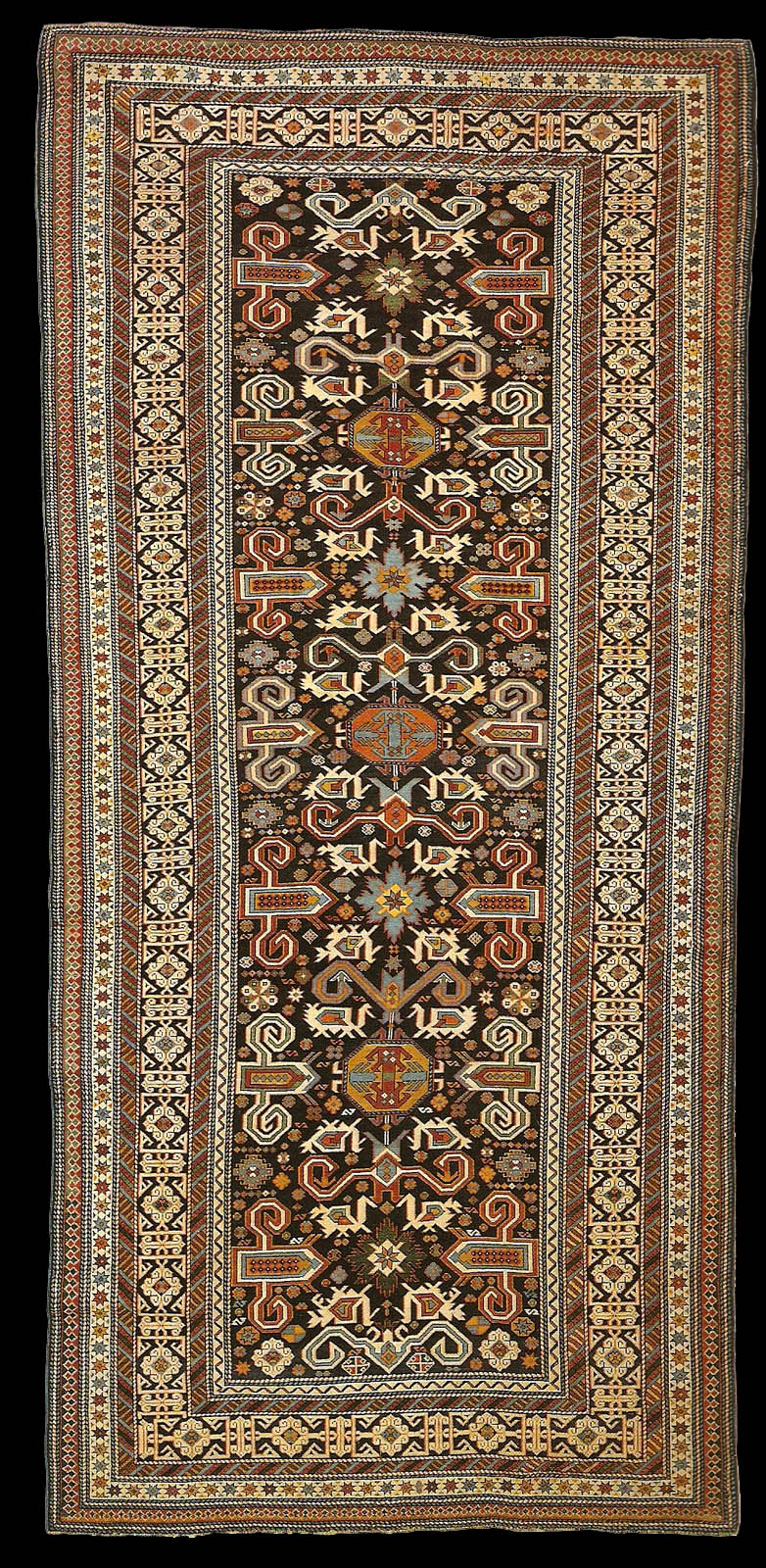 |
Antique Kuba Perepedil Runner, 401 x 184 cm, Late 19th
century (published at Alberto Boralevi "Splendori di Citta, Tesori Di Villaggio, Antichi Tappeti
Dalla Persia E Dal Caucaso", La Torre, Tappeti Orientali)
30 Kuba
Perepedil
Northeastern Caucasus, Azerbaijan
Late 19th
century
Wool pile
on wool foundation
401 x 184
cm.
This
second Perepedil with the classic blue background is unusual because of its
large size that leads us think of a carpet made to order. In the Caucasus
even though it is quite easy to find such large, rectangular carpets among
the Shirwans and Khilas as well as in those from Karabakh, it is extremely
rare to find them from the Kuba area. Among the Kubas it is much more usual
to find attractive runners that do not exceed 110-115 cm in width.
Aside
from the dimensions, the overall composition and the individual ornaments
are all typical of Perepedil production. With respect to the preceding one
with the white background, here, on the central axis along with the ragged
palmettes we also find red and yellow octagons surrounded by four of the
typical stylized bird-flowers. The secondary ornamentation is very rich and
includes nearly the entire known repertory, but oddly enough does not have
any form of stylized animals. The border motif that is also found on other
Caucasian rugs is one of the most common among the Perepedils and has been
defined as "pseudo-Kufic" because of the clear derivation from the Kufic
borders on classic Turkish rugs. This main band with white decorations on a
blue background is cleverly enclosed by five minor frames, the outermost of
which is, as required, decorated with the medacyl (medakhil) motif in
green and red, while the innermost presents a zigzag meander on a white
background. The other two frames with the diagonal polychrome bars that
directly flank the main pseudo-Kufic border are also typical. |
|
30 Kuba
Perepedil
Caucaso
Nord Orientale
Fine del
XIX secolo
Vello in
lana su armatura in lana
401 x 184
cm.
Questo
secondo esemplare di Perepedil, con il classico fondo blu, e tuttavia
insolito ed eccezionale per le grandi dimensioni, che fanno pensare ad un
tappeto tessuto su commissione. Nel Caucaso, infatti, se e abbastanza facile
trovare tappeti cosi grandi e sempre nel fbrmato allungato, tra gli Shirwan
e i Khila, oltre che nei manufatti del Karabakh, e invece estremamente
difficile vederne tra quelli dell'area di Kuba. Piuttosto tra i Kuba e
possibile trovare delle belle passatoie, che non superano i 110115 cm. di
larghezza.
A parte
le dimensioni la composizione d'assieme ed i singoli ornamenti sono tutti
caratteristici della produzione di Perepedil. Rispetto al precedente
esemplare a fondo bianco qui troviamo, infatti, allineati sull'asse centrale,
oltre alle palmette frastagliate, anche degli ottagoni in rosso e giallo
circondati da quattro dei tipici fioriuccello stilizzati. L'ornamentazione
secondaria e molto ricca e comprende quasi tutto il repertorio conosciuto.
ma, curiosamente, evita qualsiasi forma di animale stilizzato.
II motivo
della bordura, condiviso anche da altri tappeti caucasici, e quello piu
diffuso tra i Perepedil ed e defmito 'pseudocufico' per la chiara
derivazione dagli antichi bordi cufici dei tappeti turchi classici. Questa
fascia principale, a dccori bianchi su fondo blu, e mirabilmente riquadrata
da ben cinque cornici minori, delle quali la piu esterna e, come d'obbligo,
decorata con il motivo medacyl, in verde e rosso, mentre quclla piu interna
presenta un meandro a zigzag su fondo bianco. Caratteristiche sono anche le
altre due cornicette con il motivo a barre diagonali policrome, che
affiancano direttamente la fascia princjpale pseudocufica.
|

